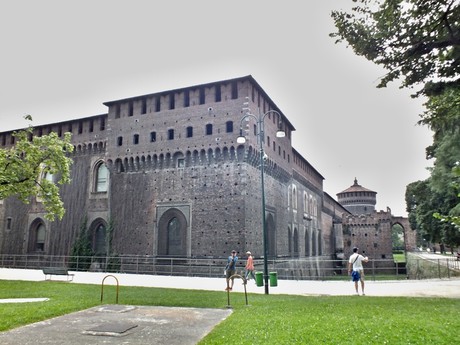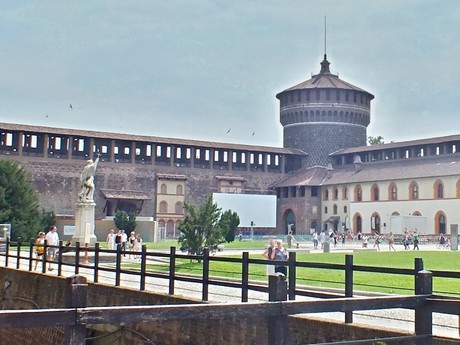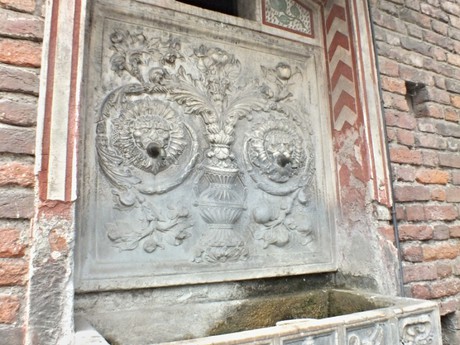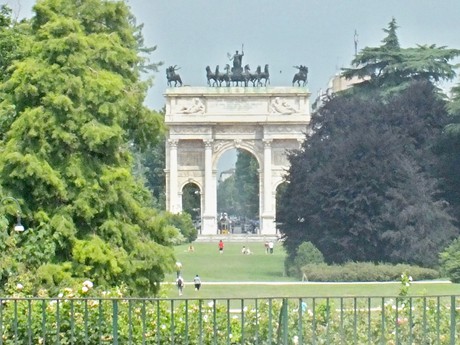Italy, Milan – Parco Sempione and Castello Sforzesco
Published: 11.7.2018
Not only the busy fashion streets are present in the city, but also the space to relax in the shade of the city parks will offer its visitors Milan. Of a number of parks, do not miss at least the city center. And this is not only because Castello Sforzesco Castle is located here.
In such a big city you can not miss the parks where you sit for a while and where you will just look in the green. There are several of them here. The nearest to the center is the Giardini della Guastalla, a small park located at the University of Milan. Its size is just for the presence of a playground and small space for dogs, but it is one of the oldest public parks in the city. There are also some architecturally attractive elements around a 17th-century pond, creating a pleasant atmosphere for relaxation.

I park Giardini Pubblici Indro Montanelli was erected near the city center as well. This important and historic city park was founded in 1784 and was named after journalist and writer Indro Montanell in 2002. You can visit it not only for relaxation, but also the Natural History Museum or Planetarium.

In the historic center along the road from the dome, your steps will surely be headed for a truly impressive park - Parco Sempione. Founded in 1893 on the site of the ancient Piazza d'armi, it occupies an area of up to 386,000 m². It is a park of romantic English style, surrounded by a rich flora, a pond with Ponte delle Sirenetta bridge (Francesco Tettamanzi) and a fountain. It is open to the public from 6.30 am. There are plenty of sports and leisure facilities for children and adults. There are also several bars, so you can sit not only on the bench but also have some coffee there.

The historic buildings and institutions of Milan are important on its edges. In the northeastern part of the park, the neo-classical Arena Civica - Arena Gianni Brera (Luigi Canonica, 1805) is built from the wreckage of a castle with a capacity of 18,000-30,000 people. It was designed for festivals, concerts and similar events. Since 2010, the rugby stadium has been staged and the Notturno di Milano athletic competition takes place here every year.

For those who love panoramic views, there is the Torre Branca (Giò Ponti, 1933), a 108.61-meter high tower. Another important landmark of the park is the Palace of Art - Palazzo dell'Arte (Giovanni Muzio, 1933). It houses the international cultural institution Triennale di Milano, which organizes national and international exhibitions and conferences in the field of contemporary art, architecture and design.
In the park you will also find a public library - the Biblioteca del Parco, an aquarium or sculpture. Among the most well-known are, for example, the history of the country (A. Paradiso), the mysterious spa (Giorgio De Chirico, 1973) and the cavalry statue of Napoleon III. (Francesco Barzaghi, 1873). Architect Park designed to create panoramic views of the city's most remarkable monuments, such as the Neo-Classical Arco della Pace and the Castello Sforzesco Castle.

Long walls of red bricks protect Castello Sforzesco castle complex and its museums. Therefore, do not hesitate to walk behind the walls of the Sforzo Residences and enter the first of the two courtyards of the complex standing in the historic center.
In the past centuries the city ohas been famous for the Viscontians and Sforzoans, who are associated with this place. Rod Visconti built here a defensive fortress (1360-1370), which was destroyed in 1447. As the Visconti died out of the sword, the government of the city takes on a new family - the Sforzo. In 1450, the present castle was built. The walls of Sala del Tesoro decorated with frescoes in 1490 Bramante. Interior decorations also featured Leonardo da Vinci, Filarete and Cesario Cesariano. The complex of the castle together with the tower was restored in the historical style by the architect Luca Beltrami (1890-1905).

Museums and painting sites are now located in individual parts of the castle. You can visit, for example, the Museo d'Arte Antica, the Museo della Preistoria, and other museums such as art, furniture, musical instruments and occasional exhibitions.

The most famous room is the Sala delle Asse, where there are ceiling paintings by Leonard Da Vinci, who for several years served as lords of the castle. The Pinacoteca del Castello Sforzesco Museum presents Da Vinci's papers as well as a collection of sculptures, the most valuable of which is the unfinished Pieta Rondanini by Michelangelo Buonarotti. The statue is his last unfinished work. Michelangelo allegedly worked on her six days before her death.
The Torre del Filarete is the entrance tower above the main entrance of the castle. He owes his name to Renaissance architect A. Averulin, known as Filarete. The 70 meter high clock tower on the top, surrounded by Fontana di Piazza Castello, is another of Milan's symbols.
GPS: 45°28'15.0"N 9°10'44.8"E (Castello Sforzesco)
Text and photos: Anna Nociarová
Edited by: Infoglobe

Related Articles
Published: 21.7.2022
Sometimes I get the impression that this part of Italy is a bit forgotten, and yet it is so beautiful. Calabria is located in the south of the Apennine Peninsula and is known mainly for its long beaches, beautiful landscape, national parks, nature and great cuisine.
Published: 23.9.2022
When you happen to visit the Italian region of Lombardy, you must definitely visit Milan. However this region also hides other places and towns that are worth a visit. We went to the city with the highest medieval tower in Italy. Come with us to the historic center of the picturesque and serene town of Cremona.
Published: 15.9.2022
Who loves music must know this city. Today, we are going tp Cremona, the town famous for violins. We will visit several monuments and introduce some personalities, including the famous poet Vergilius who studied here.
Published: 30.9.2022
Cremona is the place to nourish all your senses. We have seen and touched beautiful architectural jewels, listened to irresistible sounds of violin, and it is time to reward our taste buds. In the city, you do not just feel the scent of wood and see the colors of the violin workshops, but you can also smell the goodies they prepare in local taverns.
Published: 24.10.2018
Italy offers many architectural gems that will take you to different periods of history - from antiquity to the present. Have you heard of a small town that looks like it was from the Middle Ages?
Published: 16.12.2022
Italy is, among other things, the ideal destination for health tourism. The local spas are not just hot springs, they will always offer something extra, whether cultural activities or beautiful surroundings. Let's have a look around.
Published: 30.1.2019
Modena is now known as the industrial heart of Italy, but it does not shrink its beauty. This historic city - the seat of a bishop, university, production of balsamic vinegar and wine - attracts all visitors. We head straight to the square with the cathedral, which has been listed on UNESCO World Heritage since 1997.
Published: 14.4.2019
Italy is a country where we can admire many churches from different periods. Parma itself has over sixty. The city offers visitors an architectural and gourmet experience, which certainly cannot do without visiting a church. The sacral buildings attract not only their spiritual atmosphere, but also their art. Come with us to visit a few of them and learn what art jewels are hiding under their vaults.
Published: 21.4.2019
If you visit the Emilia-Romagna region or the area around Parma, you will certainly fall for the temptation lurking at you in the form of famous delicacies. Bite with us to delicious products. Enchanted by the beauties of Parma, we headed for one of the many farms that offers an experience not only for the eyes but also for the taste and smell of the senses.
Published: 1.12.2019
Are you wondering which ski resort in Italy to choose for your winter holiday? We will advise you which places are one of the most popular and visited in the long term. We will also tell you why.
Published: 12.9.2018
In the lines to follow, we look at some of the most important churches of Piacenza that provide space for silent contemplation, a view of beautiful artworks and a shelter from hot sunshine. Historic palaces at the same time represent the wealth and glory of the city, as well as its exceptional spirit.
Published: 5.9.2018
Even though the city is a commercial and industrial center now, the seat of the gas and oil refineries, and the World War II has hit its historcal heart, it still offers a number of beautiful historical monuments. In the following lines, we will look into its center and enjoy the local architectural gems.
Published: 18.7.2018
Milan is a city of religious history, as evidenced by the number of saints who have been here during their lives. But its greatest pride is undoubtedly the city center with the cathedral. Il Duomo di Milano can be found on all the pictures of the city, so when you visit Milan you shloud not miss this architectural gem. In the following lines we will go through not only her interior, but we will also visit the roof.
Published: 25.6.2021
The city of fashion and design, finance, sports and nightlife. This is what attracts many to Milan. And once you get to this city even though your primary destination were landmarks, you can not miss out on this side, which makes it the richest city in the country.
Published: 16.5.2018
Italy offers many interesting sights to admire. People love the country for fashion, nature, cuisine, and art as well. Yet this country is also home to great music. Today we visit the small village of Le Roncole. One of world's most famous music composers – Giuseppe Verdi was born in this very village.
Published: 20.6.2018
Milan is one of those cities where you can spend a few days and still discover something new. Since the time of the Celts, the city has developed into a modern economic center of Italy. In its tangled streets, overcrowded with cars you occasionally find some interesting sight which maybe is not one of the top attractions of Milan, but as we we are there already, why not and make a stop for a while.
Published: 6.6.2018
Milan is the second largest city in Italy and is known as the capital of fashion, sports, art, and business. We come here to complete our story about one of the most famous music composers ever - Giuseppe Verdi.
Published: 13.6.2018
When you visit Italy, you have to taste some of the local delicious cuisine. But as food art also is an integral part of the soul of this country. Italians live with music, and the visit to the Apennine Peninsula can‘t not go without a seeing musical performance. And what is more than the world-famous La Scala opera house?
Published: 23.2.2018
Brescia is Italy's hidden gem. It is easy to miss as there many towns, cities, and other places around which are promoted by tourist book guides. Milano, Gardo and Como lakes are only some of many. Yet there is a lot to see in Brescia actually. Moreover, the city sits on former important Roman trade route.
Published: 23.5.2018
Setting out from the birthplace of the famous music composer Giuseppe Verdi - Le Roncole - we go to the town Busseto, mere kilometers away. It played an important role not only in the musical but also personal life of the famous composer.
Published: 30.5.2018
We haven't left Busseto yet. We moved from its center to the outskirts of the city and to Sant'Agata three miles away. There is a farmhouse where fill the missing pieces of our knowledge of Verdi's life.
Related Photogallery
When it comes to Italy, everyone thinks of fashion, art, music, wonderful sights, exceptional gas...
In case you don't want to travel a long time and you love seaside atmosphere than Bibione, north ...
The capital of the region of Venetia in northern Italy is a place where tourists can get unforget...
One summer evening in Venice...
Foto: Jan Chaloupka, July 2012
Welcome to Pompeii, a city that was the pride of the Roman Empire and finished by natural disaste...


























![]() Information and warnings on travelling abroad is to be found HERE.
Information and warnings on travelling abroad is to be found HERE.
































